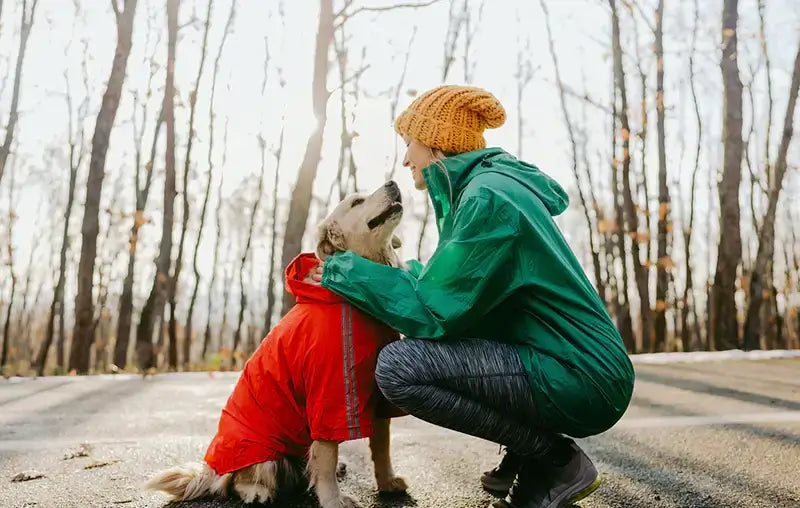
Dogs that pull on their leash, spin in circles when you’re waiting to cross the street or refuse to look the other way when another dog approaches can be a handful — especially if they’re on the larger side.
Leash manners can be difficult to achieve, but not impossible. If you put in the proper time and training, your puppy can be the epitome of refinement.
As such, we’ve outlined how to stop a dog from pulling on a leash so your walks can be just as calm-inducing as a CBD oil-infused treat.
Why Do Dogs Pull on Their Leashes?
Most often, a dog pulling on leash is due to habit. Throughout their lives, they’ve learned the best way to move forward is to go with force — and that force is only exasperated by the excitement of new sights, sounds and that pesky squirrel taunting them.
Additionally, restrainment is not natural to dogs. As such, some dogs may attempt to get out of their collars or harnesses at every opportunity to follow their exploratory instincts.
While you may want to continue to walk around the neighborhood in this state, if you continue to walk as your dog continues to pull, their behavior is encouraged, telling them that it's OK.
To mitigate or even eradicate these behaviors completely, it takes dedicated training and attention to your pup’s individual needs.
#1 Employ a Harness
Oftentimes, it’s difficult to control a rambunctious leashed dog due to its energy level or size. A pulling dog may also slip free from the head collar if it becomes too excited or spots rabbits, squirrels or other dogs. Luckily, there are many harnesses that are made for this very purpose.
Harnesses take the strain off your dog’s neck and give you more control over your pooch. Generally, there are two types of harnesses available to any dog owner for pulling pups:
- Body harness – Body harnesses typically wrap around the torso of your dog with the leash ring located on the chest of the harness. Make sure the leash ring sits high on your dog’s chest. This allows you to control their center of gravity and mitigate pulling. Most often, these types of harnesses are adjustable so you can fit them perfectly to your pup’s body without any worry of them slipping out. The harness should be snug enough to fit no more than 2 fingers between the harness and your dog’s body. If it’s too tight, it may cause discomfort or chafing.
- Head halter – Rather than the body, a head halter fits around your dog’s head and snout. The leash then attaches near your dog’s chin. The best halters will have padding around the nose and a safety clip that attaches to your dog’s collar. Because the leash is attached to your dog’s head, they have less force to pull with than if it was attached to their chest. Additionally, the halter will put pressure on the top of your dog’s muzzle, which further prevents pulling.
While harnesses and halters discourage pulling, they won’t prevent it altogether. But it will make it easier for you and your pup to take a stroll through the neighborhood.
When searching for a harness, be aware that some types of harnesses and collars may cause your dog discomfort. In general, try to avoid:
- Slip collars
- Choke collars
- Prong collars
- Electric collars
Many of these collars operate by tightening around your dog’s neck when they pull. Heavy pressure can cause damage to their vocal cords and put your dog at risk of strangulation. These types of collars may also cause your dog to associate certain sights or sounds with discomfort, which may develop in fear or aggression toward other animals or humans.
#2 Use the A, B, C’s
The A, B, C method is a way to introduce consequences to your pup and it’s effective when it comes to how to train your dog not to pull on leash.
Akin to Pavlov’s experiment, this method is a form of conditioning that aims to teach your dog rather than controlthem. To that end, it follows a correlation approach.
First, identify the A, B, C’s of your situation:
- Antecedent – What happens before your dog starts to pull on its leash? Do they spot a stimulus or does it begin immediately after walking out your front door?
- Behavior – What behavior is exhibited in addition to pulling? Many dogs may also exhibit barking, whining, jumping and twirling.
- Consequence – What happens during or immediately after your dog pulls on the leash? Do you attempt to gain control of your dog physically or verbally? How do they react?
When working with the A, B, C’s, aim to change A and C to influence B. For example, if your dog only begins pulling if they see another dog or human approach, you can outline it in the following way:
- Antecedent – Your pup sees another dog or human in the horizon
- Behavior – Your pup starts to pull and whine with excitement
- Consequence – Your dog leads you toward the other dog and distresses all involved
While it may be difficult to immediately change the antecedent and consequence in the moment, you can condition your dog afterward to prepare them for their next encounter. To do this, change your perspective to a positive reinforcement mentality:
- Antecedent – Your dog is not pulling at this moment, creating a loose leash
- Behavior – Your dog is walking beside you calmly
- Consequence – You reward your dog with words of affirmation or treats to encourage similar behaviors
You can also incorporate verbal cues into your dog training to prevent your dog from pulling, such as “Stay with me!” or “Let’s go!”
If your pup is drawn by something other than another animal or human, like approaching their favorite stream to splash in, you can work with your dog by keeping the pace and maintaining a loose leash as you head toward the destination.
It’s paramount that you reward moments when the leash is loose.
You can also pause and stop to wait for a loose leash to return. Then, reward your dog with treats.
There are also many training classes in which you can learn leash skills in a group setting. Professional training typically takes anywhere from 30 to 40 minutes a day and can last up to 8 weeks or more, depending on your pup’s specific needs.
#3 Wear Your Pup Out
While leashed walks provide mental and social stimulation, they rarely fulfill a dog’s physical needs. As such, a high-energy dog will feel excitement throughout its walk, causing them to pull toward new frontiers.
If you want to prevent high-energy walking filled with jumping or pulling, consider a
high-intensity workout instead:
- Opt for a run instead of a walk
- Stop by a dog park before you take your daily route
- Play fetch with your pup for at least 30 minutes before the outing
Giving your dog 30 to 60 minutes of uninterrupted aerobic exercise can greatly raise your chances of taking a bliss-filled walk with your canine companion.
#4 Calm Your Pup With CBD Oil
A high-energy dog may benefit from the effects of CBD oil or a CBD oil-infused treat. When a dog ingests CBD, the cannabinoids interact with your pup’s endocannabinoid system (ECS) to promote feelings of relaxation and calmness.
Consider sneaking a bit of CBD into their breakfast before their morning walk to prime your outing. Or, if you’re training your dog using the A, B, C method, you can reward your pup with CBD-infused chews to pad your dog’s behavior.
Either way, CBD oil is a nontoxic and helpful supplement that can help train your dog and keep them feeling their best.
Take a Walk With Zebra CBD
Knowing how to train a dog not to pull on leash can take some time. Ultimately, your training method will greatly depend on your pup’s disposition and docility. For further training tips, read our guide on “How to stop a dog from chewing” to learn more.
If you’re looking to add CBD into the mix, look no further than Zebra CBD.
Here, we offer a collection of dog-friendly CBD products like CBD chews and CBD oils to provide a solution to your walking woes. Our Canine Joint & Hip Chews and CBD Balm can also help ease joint and skin discomfort from harness chaffing or excessive pulling.
Each of our products is third-party tested by two independent labs, ensuring that your pup is getting high-quality ingredients for the best results. Our hemp extract may just be your gateway to peaceful walking for years to come!
Sources:
UC Davis Veterinary Medicine. Loose Leash Walking. https://healthtopics.vetmed.ucdavis.edu/health-topics/canine/loose-leash-walking
VCA Hospitals. Controlling Pulling on Walks.https://vcahospitals.com/know-your-pet/controlling-pulling-on-walks









